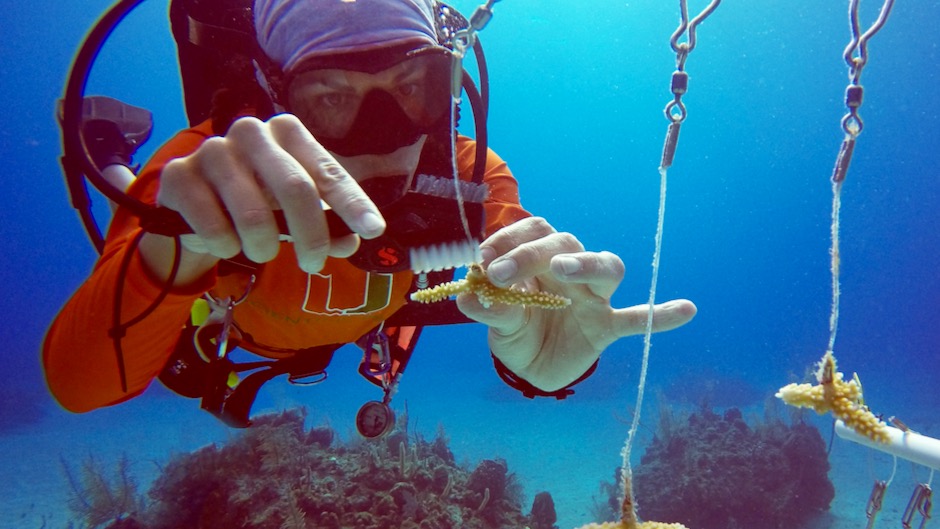Scientists publish first large-scale census of coral heat tolerance
Diana Udel, 10-20-2021

In a first-of-its-kind study, Florida’s critically endangered staghorn corals were surveyed to discover which ones can better withstand future heatwaves in the ocean. Insights from the study, led by scientists at Shedd Aquarium and the University of Miami (UM) Rosenstiel School of Marine and Atmospheric Science, help organizations working to restore climate-resilient reefs in Florida and provide a blueprint for the success of restoration projects globally.
“While this study was performed in Florida, there is growing interest among scientists and managers in surveying heat tolerance in other coral populations around the world,” said Andrew Baker, professor in the Department of Marine Biology and Ecology at the UM Rosenstiel School, and a co-author of the study. “Our study provides a template for other efforts to identify heat-tolerant corals and comes at a time when this knowledge can help transform approaches to stem the decline of corals due to climate change. Population censuses of heat tolerance are not only useful for scientists seeking to understand how and why corals vary in their thermal tolerance, but also to managers and policy makers guiding the future of reef restoration.”
The new study, published today in the Proceedings of the Royal Society B: Biological Sciences, can help optimize the human interventions necessary to help corals survive the impacts of climate change.
The study was conducted over two research expeditions that took place in 2020, where Shedd’s research vessel, the R/V Coral Reef II, enabled a team to test the heat tolerance of 229 different strains of staghorn coral (Acropora cervicornis) that are being actively propagated by South Florida’s coral restoration programs, ranging from Broward County to the lower Florida Keys, and operated by Nova Southeastern University, Mote Marine Laboratory, the Florida Fish and Wildlife Conservation Commission, Reef Renewal, the Coral Restoration Foundation, and the University of Miami Rosenstiel School.
After bringing fragments of each coral aboard the vessel, the team used a set of custom-built portable stress tanks to expose corals to different temperatures and measure how much heat stress each coral could withstand before showing the same amount of bleaching—the heat stress response in which corals expel the vital symbiotic algae that live within them. DNA samples were also taken to determine genetic factors underlying heat tolerance. The study’s results showed significant variation in the heat tolerance of the 229 corals, with certain strains exhibiting higher heat tolerance that may translate to better survival in warming oceans.
“Coral reef decline due to climate change is accelerating worldwide, but so are active reef restoration efforts, which offer the best chance to boost the resilience of reefs through challenging future environments,” said the study’s lead author Ross Cunning, a research biologist at Shedd Aquarium and alumnus of the UM Rosenstiel School. “However, restoration and other conservation interventions must be optimized with heat tolerance in mind, in order to favor the survival of future reefs in warmer oceans. In this study, we conducted the first large-scale census of coral heat tolerance to identify thermotolerant individuals, which can be immediately used for various restoration techniques.”
One restoration approach that can be optimized by the study’s findings is coral propagation and outplanting—a process in which scientists grow coral fragments in nurseries and then transfer them to reefs. In this method, the corals proven to withstand warm waters through the study could be preferentially propagated and transferred to shallow or near-shore reefs that are more likely to experience high temperatures, whereas more sensitive fragments could be placed on deeper, offshore reefs that are less likely to heat up. As more of these tolerant corals are outplanted to reefs, they will help to boost the heat tolerance of the next generation of corals and increase the climate-resilience of natural populations.
Other applications of the study include accelerating natural processes by selectively breed high-performing corals to create heat-resistant offspring, as well as transporting thermotolerant corals from reefs that are flourishing to reefs where corals are dying.
Coral reefs are biodiversity hotspots that provide storm protection, support coastal economies, and provide critical animal protein to human populations across the planet. Staghorn corals were once dominant on shallow reefs throughout the Caribbean, but have been decimated across their range since the early 1980s, making them a focal species for restoration efforts throughout the region, including Florida. Annually, tens of thousands of staghorn coral fragments are propagated and outplanted onto Florida’s reefs by restoration practitioners, making Florida’s staghorn corals the largest single-species coral restoration program in the world.
The study, “Census of heat tolerance among Florida’s threatened staghorn corals finds resilient individuals throughout existing nursery populations,” can be read online at:
http://rspb.royalsocietypublishing.org/lookup/doi/10.1098/rspb.2021.1613